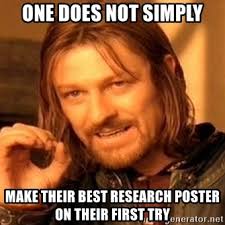As we face the middle of our semester head-first, we thought our second meeting would be best spent learning about some guidelines to consider for research poster design. To begin the discussion, Bradley put together a game of what he called, “Real Science or Not?” In this activity, Bradley pulled 13 titles from different ‘scientific’ publications. It was the group’s job to determine whether this title came from an actual, reputable science publication or from predatory journals that are not peer-reviewed and are typically aimed at making money. The purpose of this game was to get the group thinking of clear titles for research posters that are also catchy and can communicate research effectively.
Turns out, “Why Do Old Men Have Big Ears” is a real, peer-reviewed research paper. Who knew science could be effective, catchy, and silly!
Lori-Ann Palen joined us from RTI to share with us some guidelines for research poster design. To begin, Lori displayed a picture of a research poster and asked the group what they thought of the poster. Many made comments about the lack of color contrast, the abundance of text, the absence of useful graphics, etc. To add a twist, Lori revealed that this was actually her own poster from 2015-gasp! “Fear not!” she remarked, she had the tools to keep us from making the same mistakes.
Here are Lori’s “6 Kinda Important Guidelines for Research Poster Design”
1. Determine audience and purpose
It’s hard to put together a poster that will be all things for all people. It is best to pick the group you care most about. There are four groups to consider: Providers, Consumers, Collaborators, and Amplifiers. Providers are people who could get you jobs, grants, and resources. Consumers are those that could use what you’ve created in their work. Collaborators take what you have done and bring it into a new field. Amplifiers can help to get the word out about your work.
2. Start your poster planning in analog
Going low-tech in your initial planning offers a low-investment option for the early stages of your design. When you start on your computer, you will spend a lot of time perfecting things that you become attached to, and aren’t able to let go of. This can hinder your design process, and lead to an excess of material. Think about using whiteboards and sticky notes when beginning your next poster design.
3. Use 300-800 words of text
This is plenty of text to get your purpose across. You don’t need to include every detail on your poster. Get brutal, think about what your audience has to see to achieve your intended purpose. As an additional note, Lori thinks references shouldn’t be put on posters. If you are worried about this, include them on a hand-out or a QR code
4. Aim for 50/50 split for text/graphics
It is important to keep copyright in mind with photographs. Even institutional and funders logos need permission. Concerning data visualization, stay away from tables. Instead, present a statistic that reveals noteworthy correlations, percentages, and/or ratios. When including graphs, highlight the point you really want people to see so that they can draw out the information and conclusions you want.
5. Use a sans serif font that is visible from 6 feet away
Fonts: Arial, Franklin Gothic, Futura, Gill Sans, Helvetic. Heading font size should be 70-100 pt. Subheading sizes should be 40 pt. Body text should be 18-30 pt.
6. Handouts can help, use them to your advantage.
Chances are, people will only view your poster for a few minutes. Think about what you would like people to do when they leave. Include this information on the handout. A snapshot of your research with interesting graphics are great. If you’re able, having some sort of swag that can promote your work is another powerful tool. Business cards with QR codes linking to useful information are equally awesome!
*BONUS! What about colors?*
Keep text color to black or dark gray. Your background should be white or within <10% tint of another color. 3-5 color palette is recommended, but shouldn’t just be a bunch of colors. Choose a few neutrals and one pop of color. Lori recommends PowerPoint for designing your poster, but group members shared positive experiences using Inkscape, Publisher, and Canva.
Shout-out to Lori-Ann for sharing with us this super useful information!! We hope this can help in upcoming poster designs.
